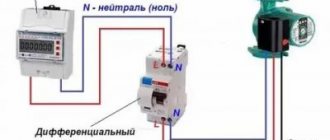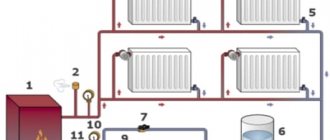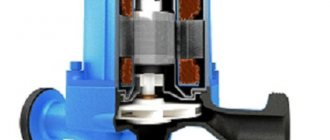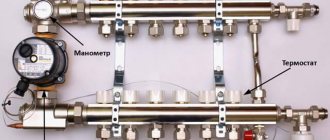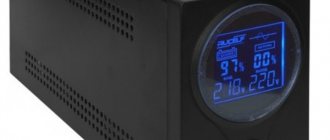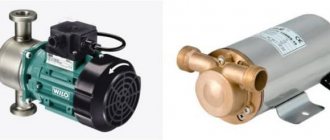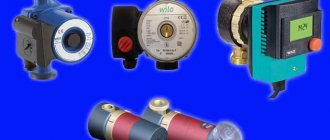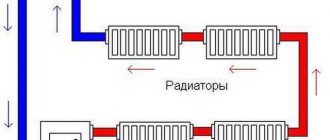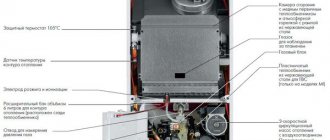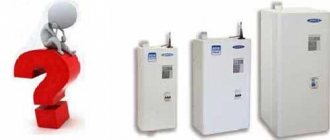Autonomous heating systems are directly related to the operation of an electric injection pump. These systems are fully operational, trouble-free and safe. But everything can change in an instant - if the centralized power supply is turned off. The likelihood that a major failure may occur in the heating circuit is very high. To prevent this from happening, you need an uninterruptible power supply for the heating circulation pump.
Advantages of uninterruptible power supply
A progressive boiler room for a private home is a rather technically complex engineering design. In addition to the gas supply for the operation of the boilers, an electricity supply is also required for the operation of the pumps. They are responsible for the circulation of coolant through the heating system.
In case of a power outage, progressive heating systems provide automatic shutdown of the heating boiler. An emergency stop of the boiler will also cause an immediate stop in the operation of the circulation pumps. The entire heating system stops working.
If there is a short-term power outage, the level of comfort in the house will decrease for some time. As soon as the power supply is restored, everything will go as before - the house will be warm and cozy.
What if the emergency situation lasts for a long time?
It is clear that the consequences of stopping heating equipment in winter are, to put it mildly, unpleasant.
If you defrost the entire heating system, replacing the distribution network throughout the house and heating radiators is almost inevitable. Repair needed. Naturally, all this will be very expensive.
Little of.
Different heating systems circulate water differently:
- Forced (water in the system is pumped through a pump).
- Natural circulation.
If the liquid in the system stops circulating, it may simply boil and lead to an explosion.
To prevent this from happening, it is advisable to acquire a backup power supply system.
It may seem that providing your boiler with a backup source of electricity is quite simple. It seems simpler - many people have a computer uninterruptible power supply in their home. Add a car battery to them and your backup power source is ready. But it's not that simple.
Let's start with the mandatory uninterruptible power supply kit:
- UPS itself for circulation pumps;
- a set of powerful batteries;
- a set of different gauge wires and cables.
The set can be supplemented with an electricity generator.
But a gas generator needs a voltage regulator and by default is not a reliable source of energy - it can break down for a long time and this will happen at the most undesirable moment.
Therefore, first, let's look at what kind of UPS there are.
What parameters need to be taken into account when choosing a UPS for a boiler
What characteristics do modern UPSs for circulation pumps have and what should you pay attention to?
Output signal shape and frequency . Many household devices are equipped with switching power supplies (for example, a PC or a modern TV), and therefore are not critical to the frequency and shape of the supply voltage. They feel great when powered by the so-called “approximated sine wave,” when this same sine wave is more like the steps of a staircase. The circulation pump motor will not tolerate such power supply - it needs a pure sine wave with a frequency of 50 Hz. Thus, for the pump we select only a UPS with a pure sine wave at the output.
Power. This parameter depends on the power consumption of the circulation pump or group of pumps that the UPS will power. When choosing a source according to this criterion, you need to make a power reserve to take into account the starting currents of the engine. We'll talk about this a little later.
Output voltage stability . The quality of work, performance and durability of the pump itself will depend on this parameter. The worse the stability, the worse the pump will feel.
Switching time to reserve . For a circulation pump, the parameter is not particularly critical. Even if the switching time is seconds (which is simply unrealistically long for any type of UPS), then a short stop and restart of the pump will not cause any problems.
Battery life without recharging. Depends on the power of the circulation pump and the capacity of the battery included.
Many UPSs for circulation pumps and boilers have terminals for connecting external batteries. This architecture is convenient due to its flexibility - upon purchase, we can equip our UPS with a battery of the required capacity.
Examples of calculations before purchasing
Now let’s try to calculate the power and battery life of the circulation pump from the UPS. As an example, let's take a pump that consumes 45 watts. Which UPS to choose? Taking into account a power reserve of 20-30%, a 60 W device is theoretically suitable. But it is not so. More precisely, not at all like that. At the moment of switching on, any electric motor consumes an increased, so-called starting current.
For household circulation pumps, this value is not particularly high, but it can exceed the rated current three times, which means that the power consumption at start-up (usually 2-3 seconds) will triple. We count:
45 x 3 + 30% = 175 W
And again, not entirely true, although in this case everything will work like a clock. The fact is that the characteristics of all UPSs for circulation pumps indicate the rated and maximum (peak) power. For the device “FORT T300 - 300/600W” these values correspond to 300 and 600 W, respectively. So, when calculating the starting load, you need to focus specifically on the maximum power of the UPS, and the rated one should be simply 20-30% higher than the pump power. We do the calculations for the same 45-watt circulation pump:
- Maximum UPS power is not less than: 45 x 3 + 30% = 175 W.
- Rated power of the UPS is not less than: 45 +30% = 58 W.
Thus, to power such a weak pump, a 60-watt UPS that can withstand a peak power of 180 watts is sufficient. The only question is, will we find such a device? A UPS with a power below 200-300 watts is a real rarity.
Important. Many models of circular pumps can operate in several power modes. When calculating the energy consumption of such a pump, it is necessary to use the maximum values - after all, you may always need to turn on the circulation of the heating system to full.
All that remains is to select a kit that will provide uninterrupted power to the pump without recharging for the time we need. As mentioned above, this time directly depends on the power of the pump and the capacity of the battery. The pump power is fixed, which means you need to select a battery of the required capacity. The latter is measured in ampere hours.
60 Ah battery
What battery capacity should we choose for our forty-five-watt pump to work, say, for a day? For a simple calculation, we use the following formula (starting currents can be ignored):
E = P * T / U ,
where E is the battery capacity in ampere hours, P is the pump power in watts, T is the required operating time in hours, U is the battery voltage in volts.
45 * 24 / 12 = 90 Ah
This formula gives a very approximate and underestimated result, since it does not take into account:
- KPD (inverter efficiency) - 0.7-0.8;
- KRA (battery discharge ratio) - 0.7-0.9;
- KDE (available capacity coefficient) - 0.7-1.0.
The value of the coefficients is quite difficult to find; they are not constant values and depend on the discharge rate (load power), ambient temperature, “age”, type and condition of the battery, speed and frequency of battery charging. To simplify the calculation, you can take the values of all coefficients equal to the average value of 0.5. In this case, the formula will look like:
E = ( P * T / U ) / 0.5
We substitute our values and get the result:
(45 * 24 / 12) / 0.5 = 180 Ah
Expert opinion
Alexey Bartosh
Specialist in repair and maintenance of electrical equipment and industrial electronics.
Ask a Question
When choosing a battery for an uninterruptible power supply, you should give preference to AGM and GEL batteries. Power supplies with liquid electrolyte in the UPS quickly degrade (lose electrical capacity) due to stratification of the electrolyte, when, due to the lack of pumping and at low charging currents, the acid ends up at the bottom of the battery and the water at the top.
UPS classification
There are certain differences in different UPS depending on the required data and layout features. They are divided into three key varieties:
- backup uninterruptible power supplies;
- linear-interactive;
- Double invert UPS.
Reserve
In normal mode, the boiler is powered from the mains. In the event of a catastrophic shutdown, the automation itself switches to battery power. But there is one indispensable condition - convert direct voltage into alternating voltage and increase it to 220 volts.
In devices of this level, the voltage is not balanced, but a passive network filter can be used to the maximum against voltage fluctuations.
Pros:
- They have decent efficiency;
- Minimal heat generation and noise;
- Relatively inexpensive.
Minuses:
- Reconnection takes a long time;
- It is quite possible to obtain a distorted voltage at the output;
- Amplitude and frequency cannot be adjusted.
Linear interactive
Here a simple stabilizer is included in the circuit. It is used to equalize voltage. In essence, this is an ordinary autotransformer with an electronic switch. If we include such a stabilizer in the UPS circuit, we will obtain output voltage parameters absolutely no different from the nominal one. Also, such devices are supplemented with a voltage converter, as well as a mandatory surge protector.
Pros:
- They have high efficiency;
- Minimum noise level;
- Stable voltage.
Minuses:
- Reconnection takes a long time;
- Insufficient accuracy;
- Trapezoidal stress shape;
- Frequency offset may occur.
Double invert UPS
The uninterruptible power supply for a heating pump with dual conversion is fundamentally different from previous schemes. Thanks to this technology, there are a number of advantages that other backup systems do not have.
Here the mains voltage is already rectified at the input and divided into two streams:
- Part goes to the capacitor bank;
- The part is converted from direct to alternating current.
Dual purpose capacitors:
- At high voltage, excess is stored.
- If the voltage drops, it releases the stored energy.
The entire process is automated through the use of a microcontroller with a quartz oscillator. This makes it possible to equalize both voltage and frequency with high accuracy.
Such UPSs are capable of operating not only to supply electricity in autonomous mode, but also serve as a means of improving the quality of electricity, on which the operation of the most critical energy supply systems depends.
A UPS for a heating pump with double inversion has its undoubted advantages over other similar systems.
Pros:
- Operate over a wide range of mains voltages;
- Very reliable correctness of stabilization;
- Instant switching to offline mode;
- Correct proportionality of frequency;
- No output interference;
- Maximum level of protection;
- Perfect voltage configuration.
Minuses:
- A bit expensive compared to other UPSs;
- Not the greatest efficiency;
- Running fans create extraneous noise.
Ideally, all uninterruptible power supplies should operate while maintaining a sinusoidal output signal. Only devices made using the double conversion program produce a clear sine wave.
Other UPSs may produce a signal that is completely different from a pure sine wave. The electric motor of the pump will work with such a sinusoid, but not for long. Eventually this will lead to poor results and a complete engine replacement will be required.
The advantage of UPSs over such additional power sources as mini-power plants or generators is precisely that they are able to switch to backup mode almost instantly in 3–11 milliseconds during emergency power outages.
And in UPS systems with double conversion, there are no switching delays at all, which has a beneficial effect on the operation of the automation system and does not stop the operation of the pump supplying water to the heating system.
On a note! Circulation pumps of boiler equipment are very demanding regarding the form of operating voltage. A UPS with a pure sine wave is preferable.
If you are choosing a UPS for a heating circulation pump, it is recommended that you carefully study the product data sheet. As a rule, the distortion factor of the current in a sinusoid is indicated there. It should not go beyond 8%.
With such a UPS, the operation of the pump will be almost silent, in addition, the service life of the pump motor itself can be significantly extended.
TEPLOCOM UPS for powering heating system pumps
has been producing specialized uninterruptible power supplies for heating systems for many years. Depending on the design of the heating system, you can select the required UPS model for heating system pumps and other equipment.
To power the circulation pumps of the heating system installed in the same room as the heating boiler, we recommend using the TEPLOCOM
power from 300 VA to 1000 VA with external batteries.
To power separately located powerful pumps of heating systems or a group of pumps, we recommend using UPS series TEPLOCOM - 250+
with built-in batteries.
To power small additional circulation pumps of the heating system, located separately, we recommend using the TEPLOCOM- 100+
.
TEPLOCOM
UPSs are designed specifically for powering heating system equipment and meet all the requirements established for power supply of such systems.
A large range of uninterruptible power supplies will allow you to choose the right UPS to power the pumps of your heating system.
Choosing a UPS for a circulation pump
For those who want to protect themselves from unexpected power outages, we have made a small selection of mandatory parameters that should be focused on first.
Outgoing current parameters
As mentioned above, a distinctive feature of a proper UPS is a clean or correct sine wave of the output signal. Deviations in the sinusoid are unacceptable. For the proper operation of a gas and solid fuel boiler with circulation pumps, such devices with dubious characteristics are absolutely unsuitable.
Before purchasing, you should look at the product data sheet and ask what type of sine wave this UPS has.
Starting power
For reliable operation of the UPS, it will be better if its power is sufficient to meet all the needs of the connected equipment. In this option, we are more interested in having enough power to operate the boiler circulation pump. It's best if UPS covers the stock by at least five times. And it’s even better if it is 7 times more than the calculated value.
You can find out the power consumption of an electric pump for a boiler room from its technical data sheet.
Source performance
Now we have smoothly moved on to batteries. The safe operation of boiler equipment is not limited to the presence of an uninterruptible power supply. A battery is vital for servicing the heating system. It’s better not even one, but several. The main thing is the battery capacity. It is measured in Ampere hours (Ah). Everything here is quite clear, the larger the capacity, the better.
But there can be several types of batteries:
- Almost every amateur motorist has the cheapest and fairly well-known acid-lead one. But they have a very unpleasant trait. During operation, harmful electrolyte vapors are released.
- There are nickel-cadmium batteries. Relatively safe and inexpensive. But they are afraid of deep discharge. If this happens, part of its capacity is lost.
- The best option for a home energy supply system is a lithium source of electricity. It does not have the disadvantages of other modifications, but they are very expensive.
When choosing an uninterruptible power supply device for a heating boiler, in addition to the main characteristics listed, there are other parameters that you should definitely pay attention to. They are purely subjective and do not affect the operation of heating systems in any way:
- Appearance
- Availability of display. It displays information about voltage and frequency.
- Accommodation option. It can be either floor or wall mounted.
- Product price. Different manufacturers of such systems have different prices.
How to choose an uninterruptible power supply
You can buy an uninterruptible power supply at any store that sells plumbing and heating equipment. There is an impressive variety of models here – it’s easy to get confused. Let's see how to choose the right uninterruptible power supply.
Selection by type
The main advantage of inverter uninterruptible power supplies is that they provide a so-called continuous sine wave - when switching from the network to the battery, the output current is not interrupted.
Of all the above UPSs, the models with double conversion (inverter) stand out with the best characteristics. Their advantages are good stabilization, the correct shape of the output voltage (sinusoid, and not its stepwise approximation or other shapes). They are also characterized by the absence of high-frequency interference at the output. Thanks to this, inverter uninterruptible power supplies can be used to power boilers with sensitive electronics on board. But they also have a minus - they are noisy, since coolers are installed inside.
Linear uninterruptible power supplies have the lowest cost. When feeding heating system pumps, they do not stabilize the mains voltage. Due to the use of the simplest converters, the shape of the output current is far from ideal - because of this, the circulation pump may fail, and you will be left without heating. But these UPSs have the highest efficiency.
Selection by power
Here you need to look at the technical data sheet for the pump and clarify its power consumption. We multiply the resulting value by 3 and obtain the maximum power of the uninterruptible power supply. The need for multiplication is explained by the fact that the heating pump is a reactive load. And at the moment of start, it consumes power 2-3 times higher than the rated one. This is precisely why we have provided a substantial reserve.
Battery capacity
Small uninterruptible power supplies can last only a few hours on batteries. On-board batteries most often have a small capacity. If power outages in your area are frequent and long-lasting, we recommend choosing a UPS with a battery capacity of a hundred amperes - depending on the power of the pump used, it can work for almost a day or even more.
To ensure long-term heating operation from a backup power source, choose uninterruptible power supplies with external plug-in batteries. The optimal type of battery is gel, maintenance-free.
Input and output voltage error
An important parameter for an uninterruptible power supply. The smaller the output error, the better - ideally no more than 5%. The greatest discrepancies are observed at the input, therefore, for correct operation of the heating, you should choose an uninterruptible power supply that can operate in a wide range of supply voltage - from 150 to 250 Volts.
Popular factory models
You can choose the right UPS both in online stores and in specialized super markets that sell accessories for heating equipment or plumbing. The choice is of course yours. And we will give only some popular models and their approximate cost.
Energy PN-1000
Energy PN-1000 is a fairly powerful device that is capable of providing uninterrupted power supply for boiler appliances. Recommended for use in a set with 100 A/h batteries. Designed to work with low-power (150 W) pumps. This device can last 9 hours offline. With a smooth sinusoid type output signal. There is a pre-installed network interference filter. For informational purposes, the front panel is equipped with a display. With a fairly high efficiency, the price for this model is 26,100 rubles.
SVC DI-600-F-LCD
Designed to support the operation of boilers and pumping stations in autonomous mode. The response speed is 15 microseconds. When using external storage units with a capacity of up to 200 A/h, the pump will operate continuously for up to 24 hours. The peak load on the uninterruptible power supply is no more than 360 W. Does not require systematic maintenance. This modification will cost about 7 thousand rubles.
Tieber T-1000
Tieber T-1000 can maintain the operation of the heating system for at least 48 hours in the event of a centralized power supply interruption. For operation, it is recommended to use a pair of gel batteries, each with a capacity of 200 Ah. Withstands peak loads up to 800 W. The output waveform is a pure sine wave. Price - 15,100 rubles.
UPS models
Energy PN-1000 is a powerful source of backup power. Thanks to the built-in stabilizer, the device provides the rated output voltage when the mains voltage changes within the range of 120-275 volts. The smooth sine waveform is ideal for powering a reactive inductive load, such as a heating system pump motor. The energy of the PN-1000, together with the Delta DTM 12100L 100A/h battery, provides uninterrupted power for a 150W heating pump for 8 hours. The device has a built-in network noise filter, information display and RS-232 interface.
You can find this and other voltage stabilizers for heating systems from the Energia company on the website of the official representative of the company VoltMarket.ru.
The compact emergency power source Teplokom 222/500 is designed for use in gas heating systems. This simple device with a single-phase relay-type stabilizer ensures operation with a load not exceeding 230 W.
The universal stabilizer Skat ST 1515 provides a voltage of 220 V with network fluctuations from 145 to 260 V and a frequency of 50 Hz ± 1%. If the voltage value exceeds the specified parameters, the load will be turned off automatically.
Let's sum it up
Based on the operational requirements for electric motors of heating system pumps, the UPS must provide the following parameters:
- Voltage shape – smooth sinusoid;
- Power reserve – at least 20%;
- Automatic load shedding;
- Minimum switching time to reserve.
In addition, the device must operate in a certain temperature range and have a device for indicating modes and physical quantities.
With this they read:
Thyristor and triac voltage stabilizers: what is the difference?
Voltage stabilizer for a gas boiler: types, selection criteria and power calculation
Choosing a relay voltage stabilizer: design, advantages and disadvantages
Choosing an electronic voltage stabilizer: operating principle and characteristics
Did you like the article? Share with friends on social networks!
Safety
When using UPS for non-stop operation of pumps in home heating systems, there are mandatory rules:
- Maintain the temperature in the room. It must comply with the recommendations specified in the technical data sheet of the product.
- Protect the device from exposure to caustic vapors of chemical reagents.
- Provide a mandatory grounding circuit.
- If a group of several batteries is used, it is not recommended to place them close to each other.
- Connect batteries of the same capacity.
- Provide fresh air to the device and batteries for cooling.
- If long-term power outages are possible, it is recommended to include an autonomous generator in the system.
How to connect the circulation pump to electricity?
The circulation pump is an important element of modern heating systems. It is needed for forced circulation of water in the heating system, which allows you to save up to 30% on heating private houses and cottages. The savings lie in the fact that the coolant quickly passes through the pipes, as a result of which the water does not cool down so quickly and, accordingly, there is no need to heat it very much. This article will discuss the correct connection of the circulation pump to the electrical network. Diagrams and video instructions will help you carry out electrical installation yourself without errors!
What is important to know?
The wiring diagram and methods of connecting a device such as a circulation pump to electricity can have different designs. The choice of a specific option is determined by the characteristics of the heated object, as well as the location where the device is located. There are two ways to connect it:
- direct connection to a 220 V power supply;
- connection to an uninterruptible power supply, which in turn is connected to a 220 V or 220/380 V network (in the case of a three-phase UPS).
By choosing the first method, the consumer risks being left without heating in the event of a prolonged power outage. This option can be considered justified only if there is a high degree of reliability of power supply, reducing the likelihood of a long power outage to a minimum, and also if there is a backup source of electrical energy at the site. The second method is preferable, although it requires additional costs.
Connection methods
Connection to the electrical network using a plug and socket . This method involves installing an electrical outlet in close proximity to the place where the circulation pump is mounted. Sometimes they can be supplied with a connected cable and plug included, as in the photo:
In this case, you can simply plug the device into the mains using an outlet located within reach of the cable. You just need to make sure there is a third, grounding contact in the outlet.
If there is no cord with a plug, they need to be purchased or removed from an unused electrical appliance. You should pay attention to the cross-section of the cord conductors. It should be between 1.5 mm2 and 2.5 mm2. The wires must be stranded copper, ensuring resistance to repeated bending. The cord with a plug for connecting electrical appliances to the network is shown in the photo below:
Before connecting the circulation pump, you need to find out which of the three wires of the cord is connected to the ground pin of the plug. This can be done using an ohmmeter, while at the same time checking the integrity of the remaining wires.
Open the terminal box cover. Inside the box there are three terminals designed to connect the device to the network, marked as in the picture:
We unscrew the clamp of the cable coupling (in the first photo it is a plastic nut into which the cable is inserted), put it on our cord, and insert the cord into the coupling. If there is a cable tie inside the box, thread the cord through it. We connect the ends of the cord wires, previously stripped of insulation, to the terminals.
The wires connected to the plugs of the plug should be connected to the L and N terminals (don’t be afraid to mix them up, this is not critical), the wire of the grounding contact of the plug should be connected to the PE terminal (but you can’t make a mistake here). The instructions supplied with the product prohibit its operation without protective grounding. Next, tighten the clamp (if any), tighten the cable sleeve clamp tightly, and close the terminal box cover. The pump is ready to be plugged into the mains.
Fixed connection. The connection diagram for the circulation pump to the electrical network with grounding is provided below:
The requirements for the wire cross-section here are the same as in the previous version. The cable for this installation can be used either flexible or inflexible, copper, VVG brand, or aluminum, AVVG. If the cable is inflexible, the installation should ensure that it does not move. To do this, the cable along the entire route is secured with clamps.
In this option, a residual current device (differential circuit breaker) is used. Instead, you can use a regular single-pole circuit breaker, passing only the phase wire through it. If the machine is installed in a panel where there is a PE bus, then the cable from the pump to the machine must be three-core. If there is no such bus, the PE terminal should be connected to a grounding device. This connection can be made with a separate wire.
Separately, I would like to consider such an installation option as connecting the pump to the UPS. It is the most preferable and ensures the independence of the heating system from power outages. The connection diagram of the circulation pump to the uninterruptible power supply is provided below:
The power of the UPS should be selected based on the power of the pump motor. The capacity of the battery is determined by the estimated time of autonomous power supply of the circulation pump, that is, the time when the power supply is turned off. We talked about how to choose a UPS for a boiler in a separate article. Requirements for cable cross-section, as well as the presence of protective grounding, apply to all connection options.
Finally, we recommend watching video instructions for connecting various pump models to the electrical network:
Connection diagram of the circulation pump to the thermostat
So we looked at how to properly connect the circulation pump to the electrical network. The diagram and video examples helped to consolidate the material and clearly see the nuances of installation!
It will be useful to read:
Source: https://samelectrik.ru/kak-podklyuchit-cirkulyacionnyj-nasos-k-elektrichestvu.html
